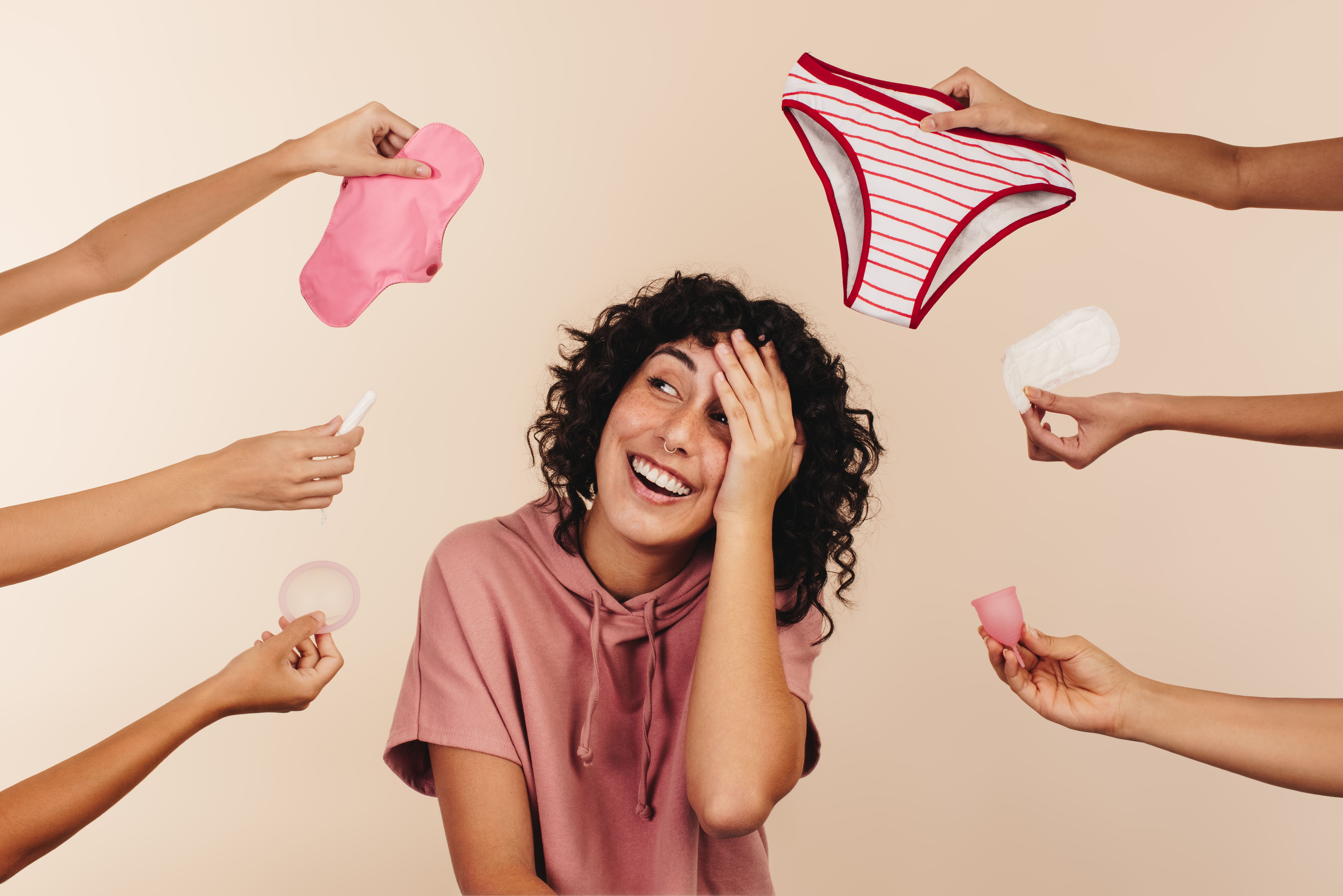Eco-friendly and cost-effective, menstrual cups can be a game changer for period care, offering a safe, comfortable and effective alternative to traditional pads and tampons. If you’re one of the billions of menstruators around the world who spend 65 days a year bleeding, having access to effective period products is crucial. 1-2 While most women and people with a uterus rely on pads and tampons, with period pants for lighter days, menstrual cups have gone mainstream, finally making it to pharmacies and supermarkets across Australia. Here’s how to use a menstrual cup, what it feels like to use one and what you need to know to get the best results.
What is a menstrual cup?
A menstrual cup is a reusable, bell-shaped device that collects menstrual blood during a period. Designs vary slightly between brands but most look like a rubbery bell with a tab for removal. The cup gets inserted into the vaginal canal, where it forms a seal to prevent leaks. The good news is, they’re safe, comfortable and they work – you just need to stick with it.
And if you have any questions about whether a menstrual cup is suitable for you or how to use it, ask your doctor, says general practitioner Dr Michela Sorensen. “I’d probably suggest seeing a female GP that you’re comfortable with and I’ve certainly had that discussion with lots of teenage girls and their mums,” Dr Sorensen says.
What are menstrual cups made from?
Most menstrual cups are made of medical-grade silicone, rubber or thermoplastic elastomer (TPE). These materials are non-toxic, hypoallergenic and biocompatible so they’re safe for use inside the body. “As long as you are washing them appropriately and changing them over regularly once they’re full and then washing them soon after in hot water they should maintain their hygiene levels and should be fine,” Dr Sorensen says.
How do they work?
Like tampons, menstrual cups are inserted into the vagina and come in various sizes.2 Most cups hold around 20-50mL of menstrual fluid, which is similar to a tampon or pad for heavy flow.2 Once inserted, the flexible material allows them to form a reliable seal to prevent leaks even while swimming, yoga or running. Depending on your flow, the cup should be emptied every four to 12 hours.1
Related Posts
How is it different to using a tampon?
Both are inserted into the vagina, so check the instructions that come with your cup on how to squeeze or fold it into a suitable shape for insertion. The biggest difference is that cups collect blood, tampons absorb blood. Menstrual cups are made of flexible, medical-grade materials, while tampons are made of absorbent cotton or rayon which some tampon-users find can lead to vaginal dryness and discomfort. The biggest difference is tampons are single use while a menstrual cup can last several years with proper care. 1-2 “In my clinical practice, I see a huge movement towards these more sustainable [options],” Dr Sorensen says. “From an environmental perspective and a cost perspective as well, I think having the reusable option is great.”
I tried a cup once and found it weird, is it really worth persisting?
Yes! A 2019 study published in The Lancet found it took “a familiarisation phase over several menstrual cycles and peer support improved uptake” to get used to using a cup.1 In other words, you’re more likely to stick with it if you try using a cup a few times during each period over the course of a year rather than instant falling it love with it. And you’re even more likely to use a cup if your friends are too, so don’t be afraid to talk about it. Another Columbian study found up to 45 per cent of users find using a cup difficult at first but among those who stick with it, up to 90 per cent are satisfied.3
Any other differences?
Wear time is notable difference. Menstrual cups can be worn for up to 12 hours, while tampons and pads generally require two to three changes over that time. Also, if you’ve ever experienced any discomfort from using traditional period products which may contain scented and bleached materials, a menstrual cup could be a big relief. Menstrual cups do not contain fragrances, chemicals, or bleaches that may cause irritation.
What are the advantages over pads and tampons?
Every day, around 800 million people around the world experience menstruation so what period care products are used has a massive impact on the environment.2 The standout feature of the menstrual cup is it’s reusable and long-lasting which comes with a much lighter environmental footprint. Multi-use period products can also save users money which can be life-changing for the millions of girls and women who struggle to afford hygiene products.
While the initial purchase price of a menstrual cup (between $20 to $70 depending on brand and whether you’re buying from the supermarket or an international website) is much higher than a box of tampons, you only need one menstrual cup which can last for years. That’s ultimately a huge saving given period products are getting increasingly expensive and one month’s worth of tampons and pads can tally up to about $20.
Is there anyone who shouldn’t use a menstrual cup?
“You do need to be careful with the cups if you have an intrauterine device (IUD) like a Mirena because sometimes the suction from the cups can move or dislodge them,” Dr Sorensen says. “Speak to your doctor if you have an IUD before you use a cup but otherwise I think they’re a good option for a lot of people.”
Do they come in varying sizes?
Yes, typically at least two sizes. Small/regular cups which hold around 20-25mL are for girls and younger women, or women who have not given birth vaginally, or those with a lighter flow. Large/plus cups which hold around 30-40mL are for women over 30 years old, or who have given birth vaginally or those with a heavier flow. Selecting the right size for your body and flow is vital since a proper fit is necessary to create the anti-leak seal.
How often do you need to empty a menstrual cup?
This varies depending on whether you’re at the start, middle or end of your period. It also depends on your flow – up to 12 hours for a lighter flow, between four to eight hours when it’s heavier. If you’re wondering how they go during sleep, the good news is they’re suitable for overnight use and many users report less leaks than with tampons or pads.
How do you clean a menstrual cup?
Proper cleaning is not only vital for maintaining hygiene, it can also extend the lifetime of your menstrual cup so always read the instructions on how to prepare your cup before using for the first time. After that, it’s as simple as making sure to wash your hands with soap and water whether you’re inserting or removing the cup – just like you would when using a tampon.
When it’s time to change your cup, simply empty the contents into the toilet and flush. Rinse the cup with cold water to remove any remaining menstrual fluid then wash thoroughly with mild unscented soap and rinse well. It’s now ready to re-insert. At the end of your cycle, it’s essential to sterilise your menstrual cup. Boil in a pot of water for 5 to 10 minutes or follow the manufacturer’s guidelines. Ensure the cup is fully dry before storing it. At the start of your next period, wash with soap and rinse well before use.
Are menstrual cups messy?
While there may be a learning curve during the initial uses, many users find that menstrual cups are not significantly messier than tampons or pads. To reduce chances of mess, take your time when removing the cup to avoid spills. Keep a damp cloth or wipes on hand and remember that it usually takes several uses to get the hang of it.
References
1. Menstrual cup use, leakage, acceptability, safety, and availability: a systematic review and meta-analysis. The Lancet Public Health. 2019. 4(8):376-393. Accessed September 2, 2023. https://doi.org/10.1016/S2468-2667(19)30111-2.
2. DeLoughery E, Colwill AC, Edelman A, et al. Red blood cell capacity of modern menstrual products: considerations for assessing heavy menstrual bleeding. BMJ Sexual & Reproductive Health. August 07, 2023. Accessed September 2, 2023. https://doi.org/10.1136/bmjsrh-2023-201895
3. Arenas-Gallo C, Ramírez-Rocha G, González-Hakspiel LC, et al. Acceptability and safety of the menstrual cup: systematic review of the literature. Rev. Colomb. obstet. gynecol. 2020 May 20;71(2):163-77. Accessed September 2, 2023. https://revista.fecolsog.org/index.php/rcog/article/view/3425






